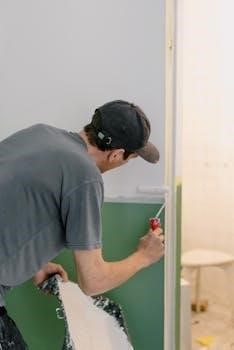marble roller coaster project pdf
Building a marble roller coaster offers an engaging, hands-on approach to exploring physics principles like gravity and energy transformation. Students can think like engineers using kinetic and potential energy concepts. This project combines fun and education.
Understanding the Physics Principles
The construction of a marble roller coaster provides a practical demonstration of several key physics principles. Primarily, it showcases the interplay between potential and kinetic energy. At the start, the marble possesses potential energy due to its height. As it descends, this potential energy converts into kinetic energy, the energy of motion. The coaster also illustrates the principles of gravity, which pulls the marble downwards, and momentum, which carries it through loops and turns. Furthermore, the project touches upon the concept of energy conservation, where energy transforms but is neither lost nor created. Understanding these principles is crucial for designing a successful and functional roller coaster.

Materials for Marble Roller Coaster Construction
Essential materials include foam tubing for the track and marbles as the rolling objects. Masking tape is also required to secure the track together. These basic items allow for a hands-on construction experience.
Foam Tubing as Track
Foam tubing, commonly used for pipe insulation, serves as an ideal material for constructing the marble roller coaster track. Its flexibility allows for easy shaping into curves, loops, and drops, essential elements of a dynamic coaster design. The soft texture of foam tubing also provides a safe and forgiving surface for the marble to roll along, minimizing friction and preventing damage. Furthermore, the lightweight nature of foam tubing makes it easy to handle and assemble, especially when using tape to secure it to other sections. This material provides a cost effective and practical solution to create complex track designs. By using foam tubing, students can easily visualize and experiment with the physics of a roller coaster.
Marbles as Rolling Objects
Marbles are perfectly suited as the rolling objects in a model roller coaster project because of their smooth, spherical shape, which allows for consistent and predictable motion along the track. Their small size makes them ideal for navigating the twists, turns, and drops of a coaster built from foam tubing. Moreover, marbles possess a mass sufficient to demonstrate the principles of kinetic and potential energy effectively. The rolling motion of marbles, rather than sliding, reduces friction, which in turn helps to maintain the energy of the system. Their use also allows for an easy observation of speed and momentum changes during the run. The simple and readily available nature of marbles makes them a perfect choice for this project.

Design and Planning of the Marble Run
Careful planning is essential for creating a successful marble roller coaster. Consider the layout, turns, and elevation changes to ensure the marble maintains its momentum and completes the course.
Layout and Design Considerations
When designing your marble roller coaster, think about the overall layout. Will it be a simple, straight track or include curves, loops, and drops? The initial height of the track is crucial for providing the marble with enough potential energy. Consider incorporating multiple chutes and turns to make the ride more exciting. The track banking is also important, especially when dealing with momentum. Also, consider the overall height of the track, and adjust the initial drop to ensure the marble has enough energy to complete the entire run. Remember that the design will influence how energy transforms, affecting the marble’s speed and motion throughout the track.

Energy Transformation in Marble Roller Coasters
Marble roller coasters beautifully demonstrate energy transformation. Potential energy at the top converts to kinetic energy as the marble rolls down. This exchange is key to understanding the physics involved in the project.
Potential Energy at the Start
At the very beginning of a marble roller coaster’s journey, the marble possesses a critical form of energy known as potential energy. This energy is not related to the marble’s motion, but rather to its position relative to the ground. Specifically, the higher the marble is positioned at the start of the track, the greater its potential energy. This stored energy is essentially the capacity to do work, and in the case of a roller coaster, it’s the potential to move and gain speed. The initial height is a crucial factor, as it determines how much energy is available to propel the marble through the track. The higher the start, the more exciting the ride. This stored energy sets the stage for the entire coaster experience, as it is the sole source of power for the marble’s movement.
Kinetic Energy During the Run
As the marble begins its descent along the roller coaster track, the potential energy it possessed at the start is progressively transformed into kinetic energy. This form of energy is associated with the marble’s motion and increases as the marble accelerates. The steeper the track, the faster the marble will move, and the more kinetic energy it will acquire. This transfer of energy is what drives the marble along the course, causing it to speed through curves and dips. At any point, the kinetic energy is directly related to the mass and velocity of the marble. The rollercoaster design should ensure that the marble has the kinetic energy needed to maintain momentum and to complete its run. The marble should be designed to use kinetic energy to travel through the track.
Construction Techniques and Tips
When building, use masking tape to securely fasten the foam tubing. This ensures track stability, allowing the marble to move smoothly. Proper connections are essential for a successful run.
Using Tape to Secure the Track
When constructing your marble roller coaster, the use of tape, particularly masking tape, becomes a crucial element in ensuring the stability and longevity of your design. Masking tape is ideal because it is both flexible and provides a good grip on the foam tubing, which is the most commonly used material for building the track. Applying the tape correctly is key; make sure to overlap the sections of tubing slightly and firmly press the tape down to create a secure connection. This will prevent the track from separating during the marble’s run. Consider using multiple layers of tape at crucial joints, especially where the track changes direction or elevation, to enhance its strength. Remember, a well-taped track is essential for a successful and smooth marble roller coaster experience. Using tape strategically will allow your marble to navigate the track with minimal interruptions.

Analyzing and Experimenting with the Design
After building, analyze your roller coaster. Experiment with the initial drop, adjusting for momentum and gravity. This iterative process helps optimize the marble’s run, allowing you to learn from each adjustment.
Experimenting with the Initial Drop
The initial drop is crucial for a successful marble roller coaster. The height of this drop significantly impacts the marble’s initial potential energy, which then converts to kinetic energy as it descends. A higher initial drop will provide more energy, potentially allowing the marble to navigate more complex sections of the track, like loops and curves. However, too much initial energy might cause the marble to derail, especially if the track design is not optimized for high speeds. Through experimentation, observe how varying the initial drop height affects the marble’s momentum and overall success in completing the course. Carefully record the results of each trial to understand the relationship between drop height and the marble’s performance.
Adjusting for Momentum and Gravity
Adjusting for momentum and gravity is key to creating a functional marble roller coaster. Momentum, the tendency of the marble to keep moving in its current direction, is crucial for navigating turns and loops. Gravity constantly acts on the marble, pulling it downward, which must be considered when designing inclines and drops. Track banking, or tilting the track on turns, can help the marble maintain its speed and direction, counteracting gravity and momentum effects. Analyze where the marble loses speed and where it might derail due to excessive momentum. By carefully modifying the track’s curves, slopes, and banking, you can optimize the marble’s run, ensuring it completes the course with a smooth and continuous motion. Remember to test and tweak your design iteratively.
